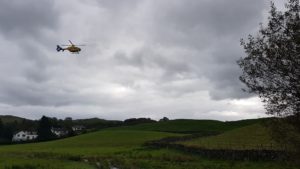Ilkley Moor and Climate Change
Ilkley Moor and Climate Change/Climate Emergency
There is general agreement that unless we all take immediate radical steps to reduce our carbon emissions, we are likely to experience potentially catastrophic climate changes that will have a profound effect on our children and grandchildren.
To combat the carbon emissions that we generate in driving our cars, heating our homes, flying away for holidays, etc. we need to find ways to capture and store carbon. There is a widespread belief that this is best done by planting trees.
But in the case of Ilkley Moor, there is a far better way.
A tree will capture carbon for 50 or 60 years. Thereafter it will store carbon for 200 to 300 years. By comparison, the peat bogs on Ilkley Moor have been capturing and storing carbon since the end of the Ice Age, 11,000 years ago. For all practical purposes, peat bogs store carbon in perpetuity.
In the late Nineteenth and early Twentieth Centuries there was a fashion for agricultural ‘improvement’. In the case of bogs, this meant drainage as they were seen as unproductive and needing to be converted into pasture etc. The most dramatic example of this was the drainage of lowland bogs in eastern England to produce fertile soils for horticulture. In colder climes the most dramatic example was the planting of trees in the Flow Country of Sutherland. We now realise how dramatically harmful this policy was, and throughout the North of England and Scotland there are schemes for the regeneration of peat bogs, because, as above, peat bogs are the finest method of carbon capture and storage available to us in this country.
In the case of Ilkley Moor, there were thriving peat bogs 100 years ago. Sphagnum peat was harvested from Hebers Moss and Crawshaw Moss for use as wound dressings in the First World War. Subsequently drainage channels (‘grips’) were cut that drain both Hebers Moss and Crawshaw Moss (we have not yet surveyed the other potential bogs).
There is still a thriving sphagnum bog on Crawshaw Moss, but we believe this bog could be encouraged to expand if the drainage were blocked. On Hebers Moss there is currently very little sphagnum moss, but we are hopeful that if the grips were blocked this might start to grow. Both these bogs are drained by Black Beck (which later becomes Hebers Ghyll). We want to explore inserting ‘soft dams’ in Black Beck to slow the flow and reduce the rate of run off. This too should help the regeneration of the bogs.
Peat bog regeneration is not a completely certain process (only about 50% of such schemes are successful) so we can maximise our chance of success by first concentrating on those bogs where there is still sphagnum growing. Currently the Environment Agency has a bog regeneration scheme on Backstone Beck. That would then leave Spicey Gill and Mill Gill to be investigated.
We must also remember that not all peat bogs are formed from mosses. Sedges (which grow freely on the wet areas of the Moor) also produce peat.
Peat bog regeneration has multiple benefits. First, it captures and stores carbon. Secondly, by reducing the rate of run-off from the Moor and by retaining rain water, it reduces the risk of flooding on the Wharfe. Thirdly, by reducing the rate of run-off it reduces erosion. Fourthly, it reduces the cost drinking water treatment by removing peat particulates and dissolved organic carbons that discolour the water and are a major cost for Yorkshire Water.
In Ilkley we are fortunate that on Ilkley Moor we have one of the finest means of carbon capture and storage. It is our duty to preserve and enhance its bogs. So, the next time someone suggests that trees should be planted on Ilkley Moor to combat climate change, please point out to them that we already have something far superior there.

